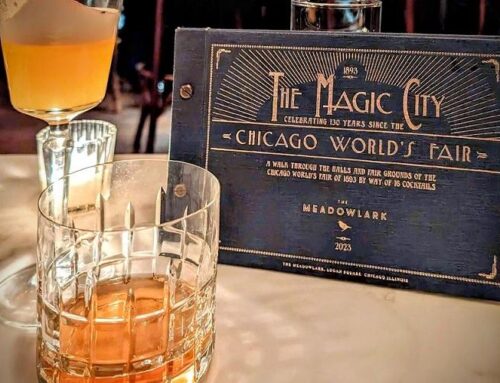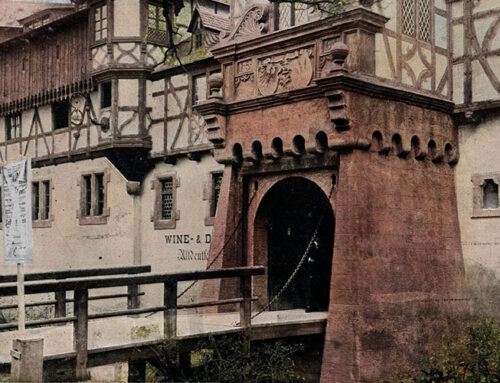On a branched timeline in the Marvel® multiverse, a few time travelers, a Norse trickster god, and an artificial intelligence disguised as an orange clock (and thought to be a ghost) visit the Midway Plaisance of the 1893 World’s Fair. Loki Season 2, Episode 3 “1893,” which premiered on Oct. 19, 2023, treated viewers to one of the most beautiful and faithful depictions of the World’s Columbian Exposition fairgrounds yet made for film or television.

This wide-angle view of the 1893 World’s Fair created for Marvel’s Loki S2E3 depicts the tower of Chinese Village and Theater on the far left, the gold onion dome of the Moorish Palace, the enormous Manufactires and Liberal Arts Building in the right background, and the German Village on the front right. The enormous Ferris Wheel in the center of the Midway is rotated ninety degrees for better visual effect.
Created using a live action set enhanced with digital graphics, the fairgrounds depicted in Loki are a disorienting amalgam of sections from Jackson Park in 1893. The Court of Honor is rotated 180 degrees, with the Administration Building along the shoreline of Lake Michigan and the Peristyle moved inland. Most of the action occurs on the Midway Plaisance, which in this recreation has moved south and positioned in line with the Court of Honor, extending directly from the Peristyle now on the west end. To further confuse perspectives, the prominent Ferris Wheel is turned ninety degrees so that it is perpendicular to the axis of the Midway.


The entry arch for Marvel’s Midway Plaisance (TOP) is evocative of the Triumphal Arch that welcomed visitors to the western entrance of the the Midway Plaisance on Cottage Grove Avenue (BOTTOM). [Image from Harper’s Weekly October 29, 1892.]
Mobius and Loki arrive in 1893 at an arch labeled “Midway Plaisance,” based on a similar Triumphal Arch that spanned the Cottage Grove entrance at the west end of the Midway. The large Midway set features several of the original attractions, including the Irish Village, German Village, the Chinese Village and Theater, Captive Balloon Ride, Volcano of Kilauea Cyclorama, and Street in Cairo and Temple of Luxor, all arranged beneath an enormous Ferris Wheel. While the overall arrangement of the international villages and other attractions is much tighter than the six hundred-foot wide Plaisance adjoining Jackson Park, the architectural and decorative designs draw heavily from images of the 1893 Fair.

The Chinese Village and Theater, one of the least popular attractions on the Midway in 1893, is featured prominently in Loki S2E3.

The Street in Cairo and the Temple of Luxor were among the most popular attraction on the original Midway.

The circular building of the Volcano of Kilauea Cyclorama can be seen briefly in the background as Victor Timely races through the Midway Plaisance.
Upon entering the fairgrounds, Mobius remembers the World’s Fair and exclaims “Edison! H. H. Holmes! hot air balloons!” Two out of three ain’t bad. Thomas Edison visited the fairgrounds in August, and H. H. Holmes seems to have visited at least once. However, the balloons at the World’s Fair employed hydrogen, not hot air, as their lifting gas. A moment later a newspaper boy shouts “Bell Liberty makes debut at Fourth of July.” In fact, the Liberty Bell had arrived in Chicago on April 28.


(TOP) Viewers get this glimpse of The Daily Chicago Press to see the article about a Midway ghost (the AI character “Miss Minutes”). (BOTTOM) An easter egg in the right-hand column is an advertisement for a World’s Fair Hotel, H. H. Holmes proprietor.
.

The original Liberty Bell travelled by train from Philadelphia to the 1893 World’s Fair in Chicago, where it was on display in the Pennsylvania Building starting in late April.
Later in the scene, Mobius states that he has explored Chinese pavilions, Bulgarian Curiosities, and a Cracker Jack concession stand. The first attraction is the Chinese Village and Theater, with its iconic structure handsomely featured in the set. A real bone for World’s Fair geeks to gnaw on is the reference to the Bulgarian Curiosities, an obscure concession selling goods from a tiny booth on the Midway’s east end. The Cracker Jack concession stand mentioned in this scene is shown later as a more historically accurate generic popcorn cart. Although the Rueckheim brothers sold a mixture of popcorn, peanuts, and molasses at the 1893 World’s Fair, their product was not named “Cracker Jack” until 1897. We’ll also note that the woman walking around the scene eating the cotton candy must by an incognito time traveler, because that spun sugar product also had not been invented yet.

This “candied popcorn and peanuts” cart may have sold a precursor to Cracker Jack (created four years after the 1893 World’s Fair) in front of the Irish Village.
.

Cotton candy at the 1893 World’s Fair is an anachronism. The spunsugar treat was popular at the 1904 World’s Fair, however.
One shot has Mobius and Loki walking by the front of a building that features a handsome suite of posters advertising the Exposition. These images are based on oil paintings by John Ross Key and one by Charles Graham.



(TOP) A poster featuring John Ross Key’s paintings of the Statue of the Republic and the Administration Building. (MIDDLE) A poster featuring John Ross Key’s painting of the Agriculture Building and Charles Graham’s painting of the Yerkes Telescope. (BOTTOM) A poster featuring John Ross Key’s painting of the Peristyle.
Two attractions appearing in the Loki scenes were not present on the actual Midway. Mobius and Loki find themselves in front of a Norwegian Village featuring carved wooded figures of Norse gods and providing an inside joke about the Marvel Universe characters. The building has a faint resemblance to the Norway Building that was located among the other foreign buildings on the main fairgrounds. Also, there was no carousel next to the Ferris Wheel, or anywhere on the Midway (although the Big Wheel was sometimes referred to as a “carousel.”)

Mobius and Loki stand in front of what appears to be a Norwegian Village, a concession not present on the Midway of the 1893 World’s Fair but resembling the Norway Building that was.

The interior of the Norway Building from the 1893 World’s Fair (which still stands today in Orkdal, Norway) features carved wood figures, though not Marvel superheroes.
Mobius mentions the “Ottoman Hippodrome and Balloon Park” referring to two attractions on the west end of the Midway. The former also went by the names Wild East Show and Bedouin Camp, while the latter featured the Captive Balloon Ride until it was destroyed on July 9 in a terrible accident due to a wind storm. Also making brief appearances in the Midway scenes are an orange juice cart that seems to reference the many Orange Cider stands dotting the Midway, and a cameo by Buffalo Bill and Annie Oakley in one shot of the Midway crowd.

A vendor selling Florida orange juice is not far-fetched, as the Midway had several orange cider concession booths.

Mobius pass between two figures in the crowd who appear to be Annie Oakley and Buffalo Bill, whose Wild West Show stood just outside of the fairgrounds.
After an extended scene taking place inside a beerhouse of the German Village, the action returns to the Plaisance with a tense fight scene inside one of the cars of the Ferris Wheel. As the characters enter the car, they pass by a Ferris Wheel attendant appearing in an authentic uniform, as does a Columbian Guard in an earlier scene.

A scene takes place inside one of the cars of the Ferris Wheel.

This startled Ferris Wheel attendant appears in an authentic uniform.

Uniforms of the Columbian Guard from Loki (LEFT) and from the 1893 World’s Columbian Exposition (RIGHT).
A stunning view from the top of the (relocated) Ferris Wheel shows a near-authentic Court of Honor, with the Statue of the Republic in the foreground (and with a correctly rendered Phrygian cap surmounting the staff in her left hand), the golden Diana atop the Agricultural Building on the left side of the Grand Basin, the obelisk in the South Canal in the back left, and MacMonnies’ Fountain in front of the central Administration Building.

A beautiful view of the Court of Honor from the top of the Ferris Wheel (repositioned behind the Peristyle). In this topsy-turvy fairground, Lake Michigan is behind the Administration Building.
In a later scene, characters view the (rotated) fairgrounds from a boat in Lake Michigan (which appears to be heading south despite having a destination of Wisconsin for the rest of the episode.)

The fairgrounds from Lake Michigan, showing the golden dome of the Administration Building with the (repositioned) Ferris Wheel and Midway behind it.
The attention to detail is what makes this fantasy fairground so captivating. The lamp posts are authentic recreations of those from 1893, and the depiction of the search lights scanning the sky is evocative of iconic nighttime images of the Dream City. This episode of Loki offers fans of the 1893 World’s Fair the most extensive and authentic depiction of the fairgrounds on film to date, exceeding on both counts efforts in the 2019 film The Current War.

Lamp posts used on the set of Loki are authentic recreations of those from the 1893 World’s Columbian Exposition fairgrounds.

The illumination of the Court of Honor photographed by D. C. Hunter Bartlett. [Image from The Graphic History of the Fair. Graphic Co., 1894.]






This was an amazing read thanks so much for diving so deep into the Production design compared to the original Worlds Fair.
Good facts about the set, BUT where was Loki Loki filmed?
LOKI Season 2 was filmed in the U.K., and this episode appears to be almost entirely on a set.